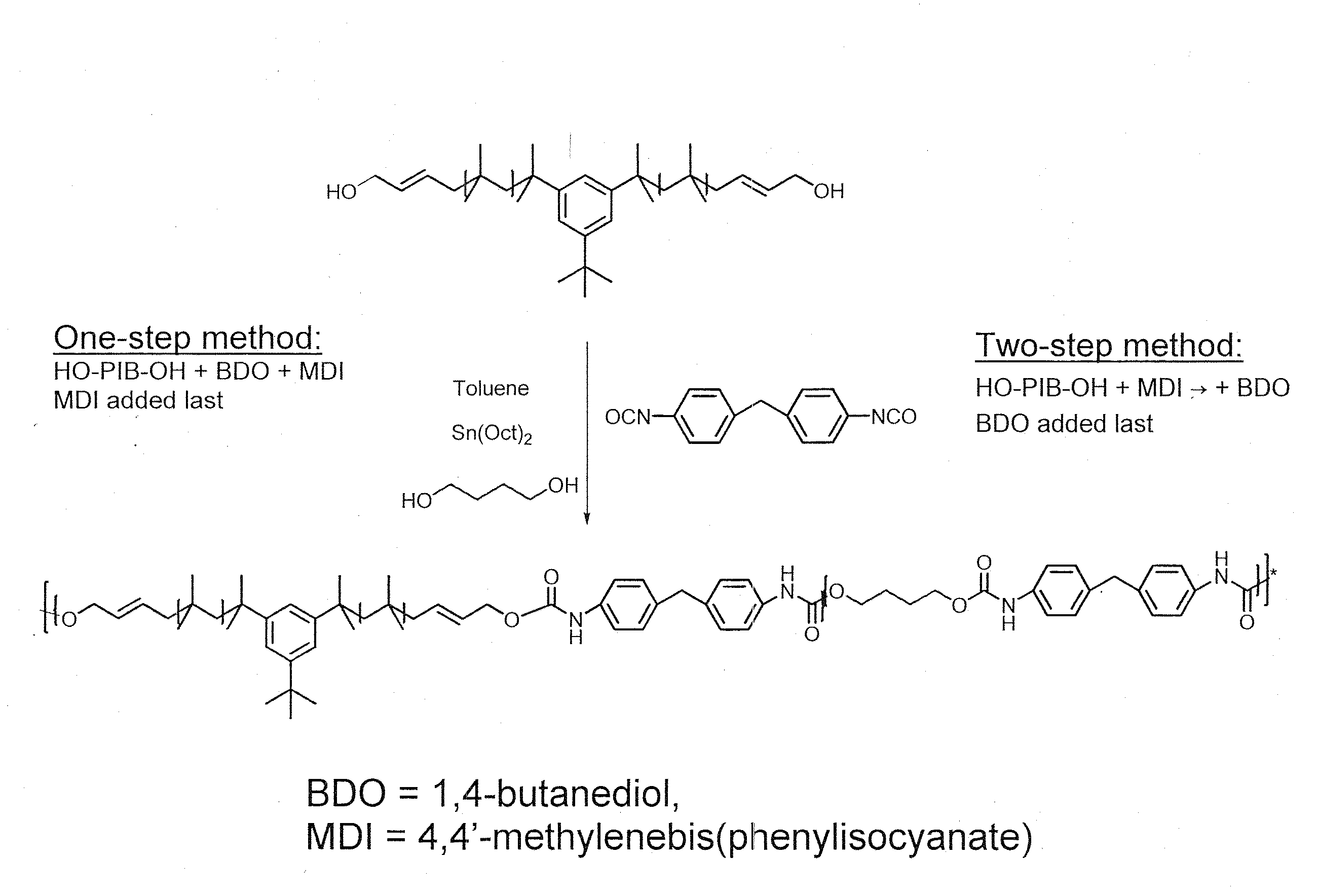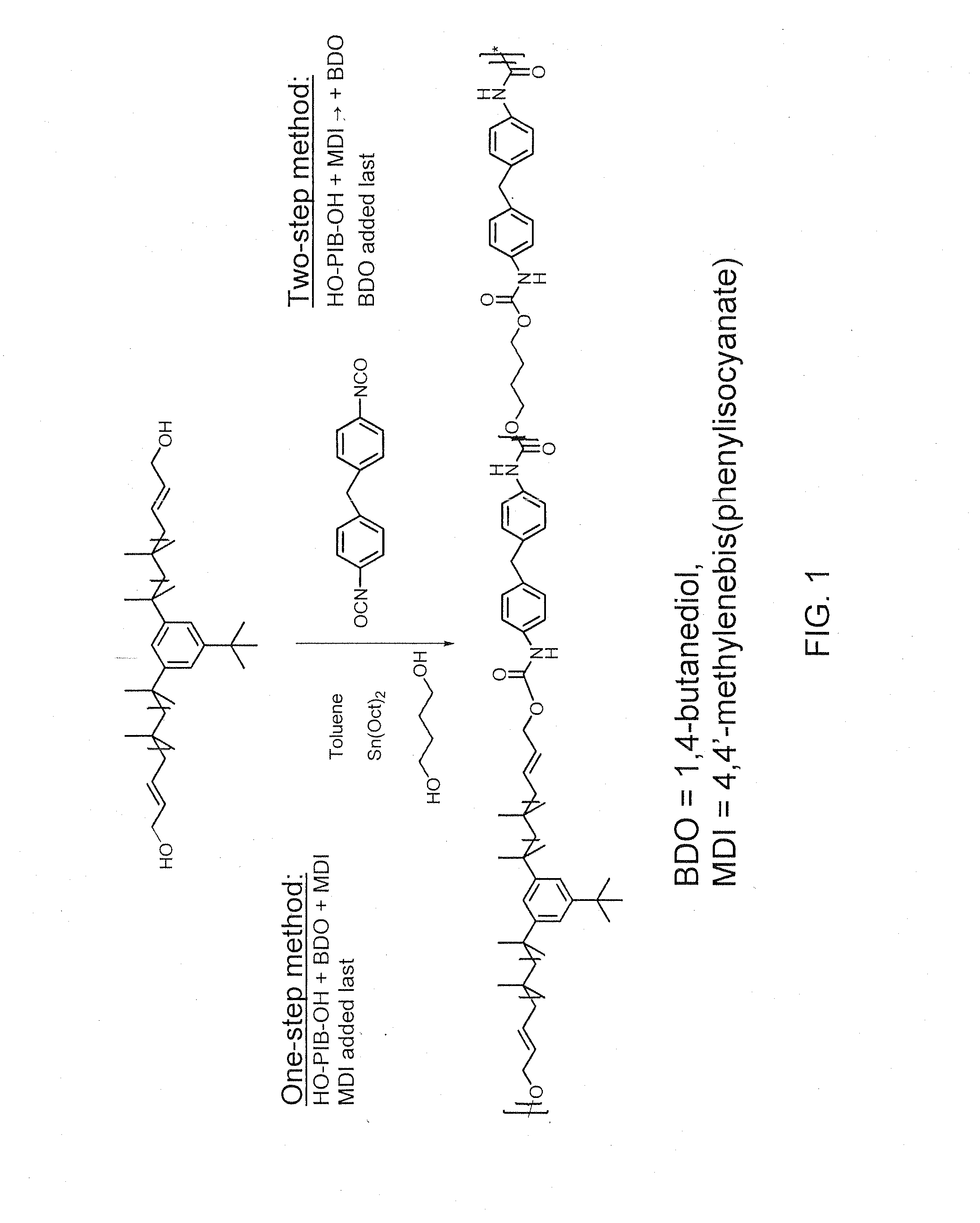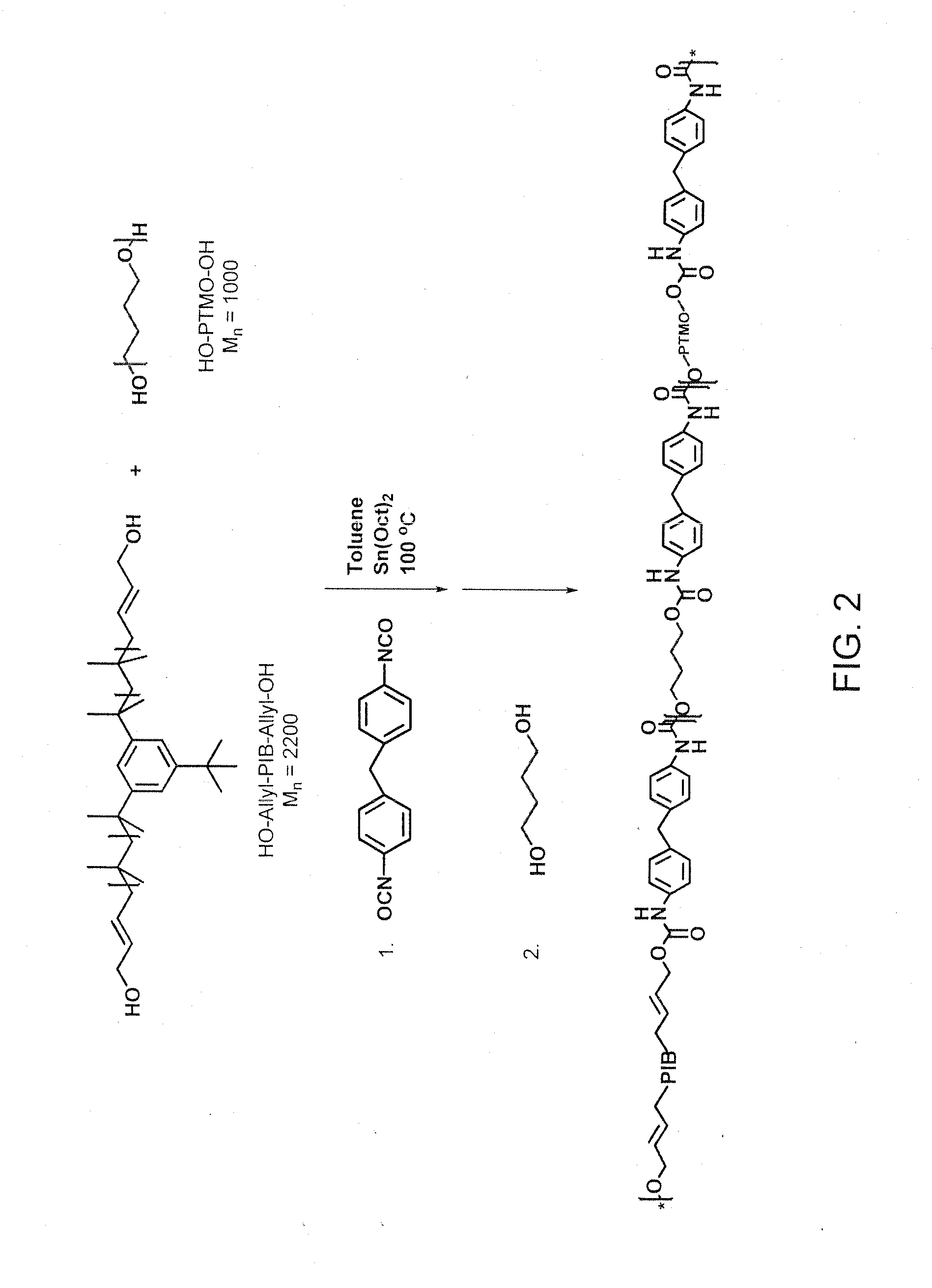Polyisobutylene-Based Polyurethanes
a polybutylene and polyurethane technology, applied in the field of polyisobutylene-based polyurethanes, can solve the problems of insufficient resistance of polyether components, insufficient tensile strength of polyethylene components, and insufficient thermal and oxidative stability of polydienes, so as to achieve significant oxidative stability, improve tensile strength and percent elongation
- Summary
- Abstract
- Description
- Claims
- Application Information
AI Technical Summary
Benefits of technology
Problems solved by technology
Method used
Image
Examples
example 1
Preparation of Ho-allyl-Polyisobutylene(PIB)-allyl-OH
[0100]The synthesis of HO-Allyl-PIB-Allyl-OH was carried out by heating the THF solution of bromoallyl telechelic PIB with aqueous solution of KOH at 130° C. for 3 hours.
[0101]For example, Br-Allyl-PIB-Allyl-Br (Mn=2200, 50 g, 0.023 mol) was dissolved in dry THF (1 liter) and a solution of KOH (50 g, 0.9 mol) in distilled water (500 mL) was added to it. The mixture was heated for 3 hour at 130° C. in a reactor. The reaction was cooled to room temperature. The THF was evaporated using a rotary evaporator. Distilled methanol (500 mL) was added and the precipitate was allowed to settle down. The precipitate was further dissolved in hexanes (200 mL) and slowly added to methanol (600 mL). The sticky mass was allowed to settle down. The process was repeated two times and the purified polymer was finally dried under vacuum at room temperature for 24 hour. Yield: 99%, GPC-MALLS: Mn=2400, polydispersity index (PDI)=1.16.
[0102]Representativ...
example 2
Syntheses of Polyisobutylene-Based Thermoplastic Polyurethane (PIB-TPU)
[0103]As used in Example 2, the terms “one-step procedure” and “two-step procedure” refer to the synthetic scheme exemplified in FIG. 1.
[0104]The syntheses of polyurethanes (PUs) with the ratio of soft segment (SS) to hard segment (HS) 80:20 (wt:wt), i.e. PIB(4200)-TPU (Sample Code PIB-TPU-4321), PIB(2200)-TPU (Sample Code PIB-TPU-2211) and PIB(1500)-TPU (Sample Code PIB-TPU-1514) were carried out in toluene using MDI and BDO as the chain extender in presence of 1 mol % of stannous octoate (relative to MDI) at 80° C. The polymers were obtained by adding MDI as the last reagent (one-step procedure).
One-Step Procedure
[0105]For examples, the material PIB-TPU-2211 was synthesized as follows. HO-Allyl-PIB-Allyl-OH (Mn=2200, 5.2 g, 2.36 mmol) and BDO (212 mg, 2.36 mmol) were azeotropically distilled from dry toluene (10 mL). The mixture was kept at 45° C. for 3 hours under vacuum. 25 mL of dry toluene was added to this...
example 3
Synthesis of Polyisobutylene / Polyether-Based Thermoplastic Urethane (PIB-PTMO-TPU)
[0116]TPUs having mixtures of PIB and PTMO in different proportions as soft segment were synthesized using the two-step procedure according to the synthetic procedure exemplified in FIG. 2. BDO and MDI constituted the hard segment. The soft segment to hard segment ratio of 80:20 wt % was maintained in all the cases.
[0117]For example, PIB-PTMO-82-6 was synthesized as follows. HO-Allyl-PIB-Allyl-OH (Mn=2200, 5.2 g, 2.36 mmol) and PTMO (Mn=1000, 1.3 g, 1.3 mmol) were azeotropically distilled from dry toluene (10 mL). The mixture was kept at 45° C. for 3 hours under vacuum. 25 mL of dry toluene was added to this mixture, followed by Sn(Oct)2 (28.3 mg, 0.07 mmol) in toluene. The mixture was heated at 80° C. under a slow stream of dry nitrogen gas. MDI (1.76 g, 7.02 mmol) was added to this mixture and the mixture was stirred vigorously for 30 min. BDO (302 mg, 3.36 mmol) was added to the resulting reaction m...
PUM
| Property | Measurement | Unit |
|---|---|---|
| molecular weight | aaaaa | aaaaa |
| molecular weight | aaaaa | aaaaa |
| molecular weight | aaaaa | aaaaa |
Abstract
Description
Claims
Application Information
 Login to View More
Login to View More - R&D
- Intellectual Property
- Life Sciences
- Materials
- Tech Scout
- Unparalleled Data Quality
- Higher Quality Content
- 60% Fewer Hallucinations
Browse by: Latest US Patents, China's latest patents, Technical Efficacy Thesaurus, Application Domain, Technology Topic, Popular Technical Reports.
© 2025 PatSnap. All rights reserved.Legal|Privacy policy|Modern Slavery Act Transparency Statement|Sitemap|About US| Contact US: help@patsnap.com



